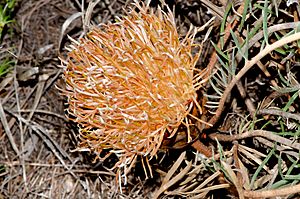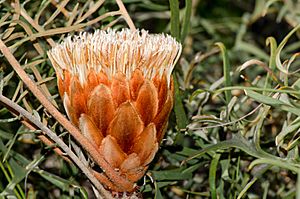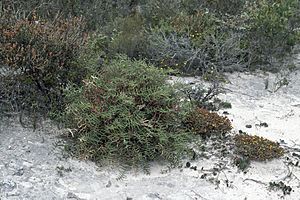Tangled honeypot facts for kids
Quick facts for kids Tangled honeypot |
|
|---|---|
 |
|
| Open flowers of a Tangled Honeypot plant (the vernalis type) | |
| Scientific classification | |
| Genus: |
Banksia
|
| Species: |
pteridifolia
|
The Tangled Honeypot (Banksia pteridifolia) is a special kind of shrub. It grows only in the southwest part of Western Australia. This plant has short stems that grow underground. Its leaves are deeply cut with sharp, thin parts on the sides. The flowers are creamy white or yellow and grow in groups of about one hundred. After flowering, each group can form up to five seed pods.
Contents
What Does the Tangled Honeypot Look Like?
The Tangled Honeypot is a shrub that usually spreads out to about 1 meter (3 feet) wide. It has short stems that stay hidden underground. It also has a special woody base called a lignotuber that helps it regrow after fires.
Leaves and Flowers
Its leaves are long, between 17 and 50 centimeters (7-20 inches) in length. They are also 5 to 12 centimeters (2-5 inches) wide. Each leaf has many sharp, thin parts, usually 20 to 34 of them on each side. These parts are about 1.5 to 5 millimeters wide.
The plant produces lovely creamy white, yellow, or sometimes pinkish flowers. About 90 to 100 flowers grow together in a single head at the end of the stems. These flower heads are surrounded by the plant's leaves. At the bottom of each flower head, there are special leaf-like parts called bracts. These bracts are egg-shaped and covered with rusty-colored, fuzzy hairs.
The flowers themselves are about 3.6 to 3.9 centimeters long. The part of the flower that holds the seeds (called the pistil) is even longer, about 3.8 to 5.3 centimeters. You can see these plants flowering from March to May or from September to October. After the flowers fade, up to five egg-shaped seed pods, about 1.7 to 1.8 centimeters long, form in each head.
How the Tangled Honeypot Got Its Name
A Scottish plant expert named Robert Brown first described this plant in 1810. He called it Dryandra pteridifolia. He found it in January 1802 at Lucky Bay on the south coast of Western Australia.
Later, in 1996, another expert named Alex George found two slightly different types of this plant. He called them subspecies pteridifolia and subspecies vernalis. He later found a third type, subspecies inretita.
In 2007, two other scientists, Austin Mast and Kevin Thiele, moved all Dryandra plants into the Banksia group. So, the Tangled Honeypot became Banksia pteridifolia. Its different types are now known as Banksia pteridifolia subsp. pteridifolia, vernalis, and inretita.
Different Types of Tangled Honeypot
There are a few ways to tell the three types of Tangled Honeypot apart:
- Banksia pteridifolia subsp. inretita has flower heads surrounded by short leaves with very thin, thread-like parts.
- The other two types do not have short leaves around their flower heads.
- Banksia pteridifolia subsp. pteridifolia has twisted leaf parts and flowers in autumn.
- B. pteridifolia subsp. vernalis has leaf parts that are only slightly twisted, or not twisted at all. It flowers in spring.
Where the Tangled Honeypot Lives
All three types of Banksia pteridifolia grow in a special kind of shrubland called kwongan.
- The inretita type is found between Lake Grace and Lake King.
- The pteridifolia type grows between the Gairdner River, Cape Le Grand National Park, and Newdegate.
- The vernalis type lives between Eneabba, the Moore River, and Perth.
Protecting the Tangled Honeypot
The Western Australian Government's Department of Parks and Wildlife keeps track of these plants.
- The pteridifolia type is considered "not threatened," meaning it's doing well.
- The inretita type is listed as "Priority Two." This means it's not very well known and only found in a few places.
- The vernalis type is listed as "Priority Three." This means it's also not very well known and found in only a few spots, but it's not in immediate danger.



